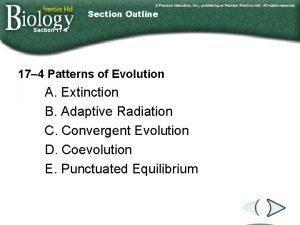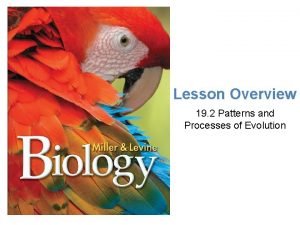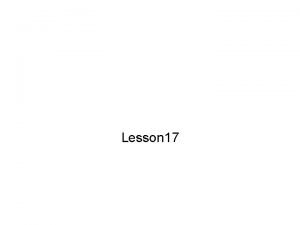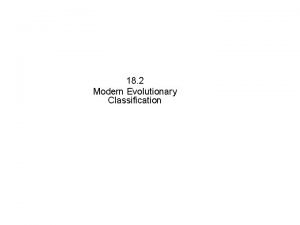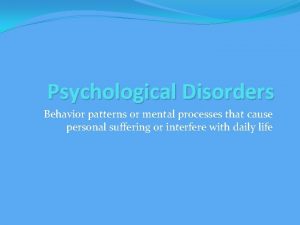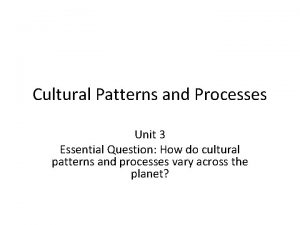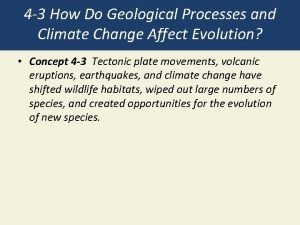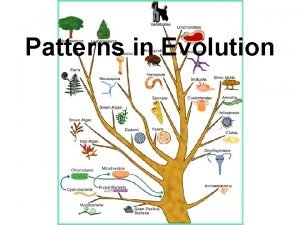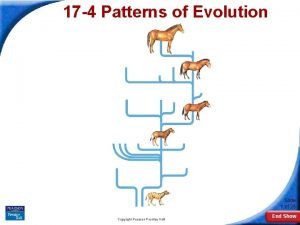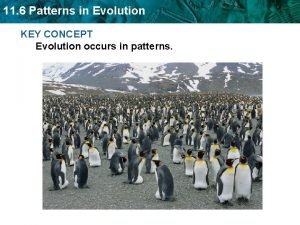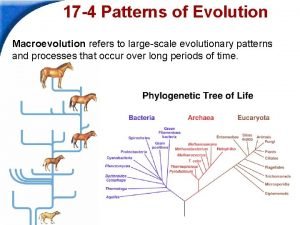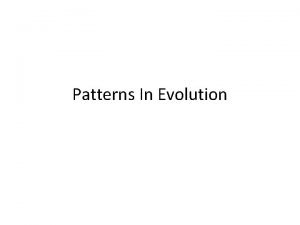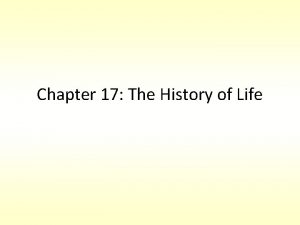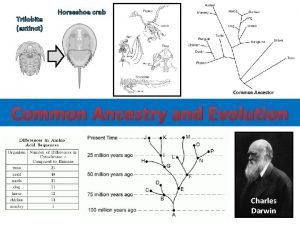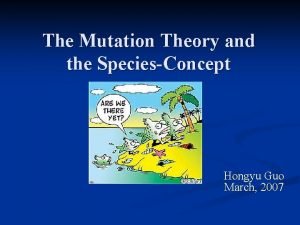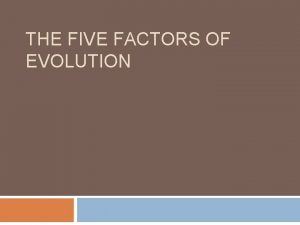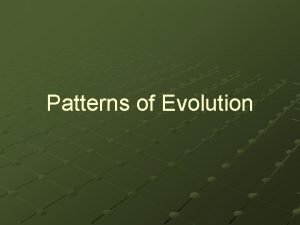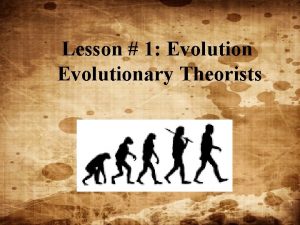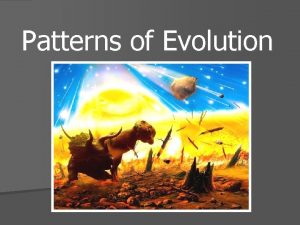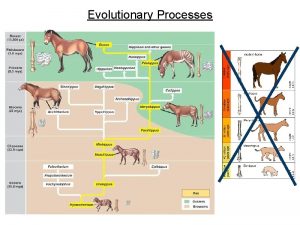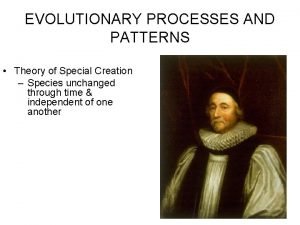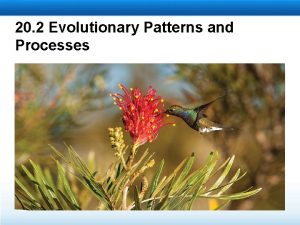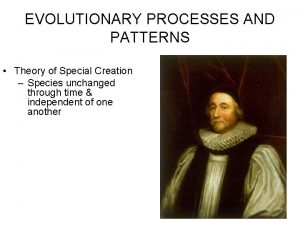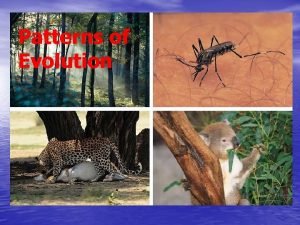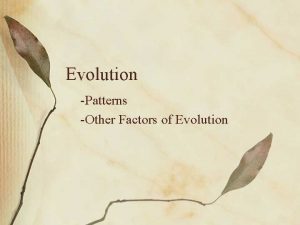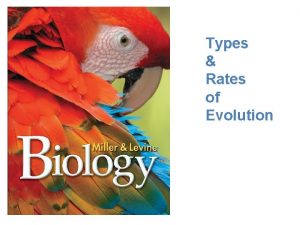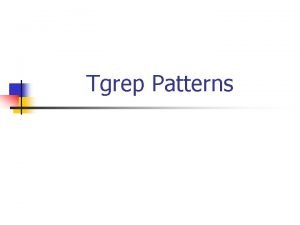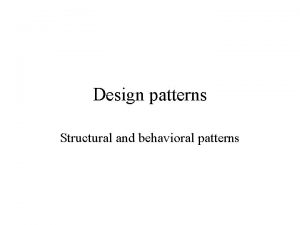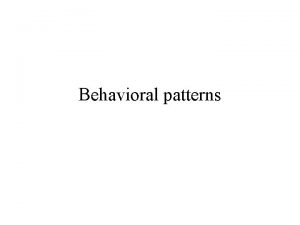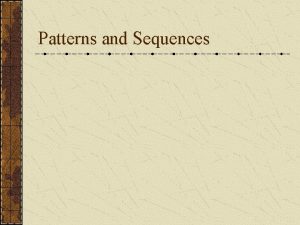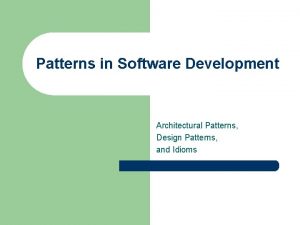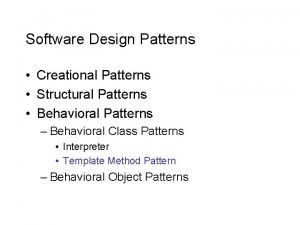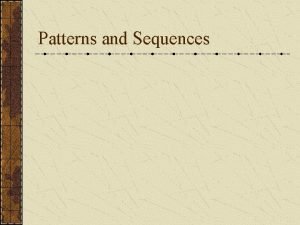Lesson 7 Evolution Processes Patterns of Evolution Evolutionary





















- Slides: 21

Lesson # 7: Evolution (Processes + Patterns of Evolution)

Evolutionary Change via Selection - Types of selective pressures may result from: i. e. climate conditions, food availability, predators, and choice of mate etc. - There are four types of selection: 1) Directional Selection 2) Stabilizing Selection 3) Disruptive Selection 4) Sexual Selection

Types of Selection 1) Directional Selection - Favours an increase or decrease in the value of a trait from the current population average - Occurs when the environment favours one EXTREME trait - Causes average to move in one direction, the average has moved to one extreme - The result is a shift away from the average - Often happens when environment changes in a consistent way Examples àFishing with nets àHummingbirds using their bills to feed on nectar - Very common in artificial selection… why? - How would necks of giraffes or camouflage / mimicry help explain directional selection?

DIRECTIONAL SELECTION

Types of Selection 2) Stabilizing Selection - Selection against individuals exhibiting traits that deviate from the current population average - The most common trait is the favoured trait - Most common form of selection - Once a species adapts to its environment, selective pressures maintain the evolved feature Example - Human birth weight - Medium sized hummingbird bill length What other examples can you think of?

STABILIZING SELECTION

Types of Selection 3) Disruptive Selection - Selection that favours two or more variations of a trait that differ from the current population average - Favours traits at both EXTREMES - Causes species to diverge - Occurs when two different types of resources are in one area - May lead to formation of new species Examples - (e. g. , Darwin’s finches – small beaked ate small seeds and big beaked ate large seed; yet, medium beaked could not eat or compete for either seed size (unfavourable))

DISRUPTIVE SELECTION

Types of Selection 4) Sexual Selection - Favouring of any trait that specifically enhances the mating success of an individual - Often leads males and females of a species evolving appearances and behaviours that are quite different from each other - Most common behaviour is the female selects male, and the males compete one against one another - Most females choose mates based on physical traits, or behaviours - Some traits, while sexually attractive are detrimental Examples - Bright coloured feathers of a male peacock is attractive for females but easy for predators to see - A very successful male elephant seal may mate with dozens of females each year and hundreds of females in his lifetime, while a weak male may live a longer life but produce no offspring. In this case, the genes of the short lived but dominant male are destined to become more common in succeeding generations


Evolutionary Change Without Selection - Not all evolutionary changes are the result of natural selection - Sometimes there are changes in the genetic make up of a population that are not influenced by the traits of individuals - Each of these changes tends to reduce genetic diversity within a population Types of Evolutionary Change Without Selection 1) Genetic Drift 2) Bottleneck and the Founder Effect 3) The Hardy – Weinberg Principle

Evolutionary Change Without Selection 1) Genetic Drift - The genetic make up of a population can change simply by chance - The random shifting of the genetic makeup of the next generation - The smaller the number of individuals in a population, the greater the influence of genetic drift - In small populations, genetic drift can result in a particular allele becoming either very common or disappearing entirely over a number of generations - Any lost alleles result in a reduction of genetic diversity of the population

Evolutionary Change Without Selection 2) Bottleneck Effect - A loss in genetic diversity following an extreme reduction in the size of a population Example - If an individual population of 10, 000 individuals is reduced to only 50 individuals, they are unlikely to contain all of the traits found in the larger population - Many traits, and in particular rare ones are likely to be eliminated - If the population is allowed to recover, the genetic make up of future generations will be limited to the traits carried by those 50 surviving individuals and any new mutations


Evolutionary Change Without Selection 3) Founder Effect - Occurs when a small number of individuals establish a new population - The new population will begin with a different gene pool than the original mainland population’s gene pool

Evolutionary Change Without Selection 4) The Hardy – Weinberg Principle - In the large populations in which only random chance is at work, allele frequencies are expected to remain constant from generation to generation - Based on the Hardy – Weinberg principle, biologists recognize that the following conditions result in evolution: àNatural selection – favours the passing on os some alleles over others àSmall population size – increases the likelihood of genetic drift àMutation – introduces new alleles to a population àImmigration or emigration - introduces or removes alleles in a population àHorizontal gene transfer – the gaining of new alleles from different species

Patterns of Evolution - Natural selection leads to predictable outcomes 1) Adaptive Radiation - Occurs when a single species evolves into a number of distinct but closely related species - Each new species fills a different ecological niche - This process usually occurs when a variety of new resources become available (and are not being used by other species) - Only real competition is with each other

1. Species A migrates from the mainland to the first island. 2. Isolated from the mainland, species A evolves to species B. 3. Species B migrates to the second island. 4. Species B evolves in species C. 5. Species C recolonizes the first islands, but is now unable to reproduce with species B. 6. Species C migrates to the third island. 7. Species C evolves into species D. 8. Species D migrates to the first and second island. 9. Species D evolves to species E. This process might go on indefinitely until a large diversity is reached.

Patterns of Evolution 2) Divergent Evolution - In any ecosystem, there a number of ecological niches - This is the large scale evolution of a group into many different forms - Accumulation of differences between groups which can lead to the formation of new species (great variety of species) Example - Ontario forests have over 20 species of closely related rodents including deer mouse, flying squirrel, porcupine and beaver - All which evolved from a single common ancestor

Patterns of Evolution 3) Convergent Evolution - Occurs when two different species, evolve to occupy similar ecological niches - When two different species have evolved similar traits in the same ecological niche Examples - Cacti and euphorbia

Patterns of Evolution 4) Coevolution - A process in which one species evolves in response to the evolution of another species Example - Certain plants have evolved hard protective shells to protect their seeds, while some seed – eating mammals have evolved powerful jaws and teeth for chewing through hard shells - Any seeds surrounded by a hard shell might be better protected from herbivores and better able to survive than seeds with thin shells - Similarly, any herbivore with a slightly more powerful jaw might be able to acquire more food than a herbivore with a less powerful jaw. - This is sometimes called an “evolutionary arms race” àStruggle between competing sets of co-evolving genes, traits, or species, that develop adaptations and counter-adaptations against each other, resembling an arms race
 Section 17-4 patterns of evolution
Section 17-4 patterns of evolution Lesson 17: patterns and processes of evolution
Lesson 17: patterns and processes of evolution Lesson 17 patterns and processes of evolution
Lesson 17 patterns and processes of evolution Section 3 other mechanisms of evolution
Section 3 other mechanisms of evolution Concurrent processes are processes that
Concurrent processes are processes that 19.2 modern evolutionary classification
19.2 modern evolutionary classification Behavior patterns or mental processes that interfere
Behavior patterns or mental processes that interfere Cultural patterns and processes
Cultural patterns and processes How do geological processes affect evolution
How do geological processes affect evolution Dating patterns since the 1960s are
Dating patterns since the 1960s are X videos
X videos Diverging evolution
Diverging evolution 17-4 patterns of evolution
17-4 patterns of evolution 6 patterns of evolution
6 patterns of evolution Connecting the concepts macroevolution
Connecting the concepts macroevolution Macroevolution
Macroevolution Section 17-4 patterns of evolution
Section 17-4 patterns of evolution Evolutionary perspective of psychology
Evolutionary perspective of psychology Evolutionary fuzzing
Evolutionary fuzzing Horseshoe crab trilobite
Horseshoe crab trilobite Modern evolutionary synthesis
Modern evolutionary synthesis The five factors of evolution
The five factors of evolution
